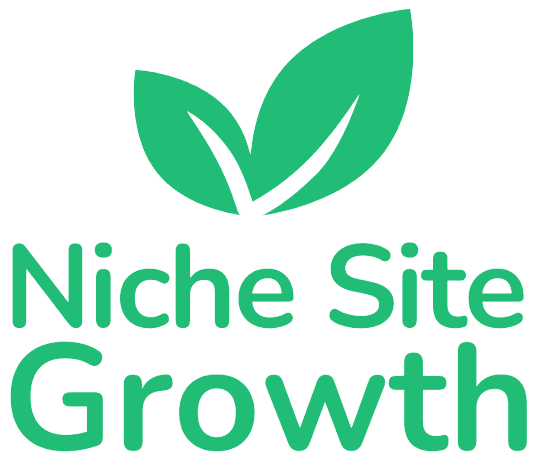The AI niche is exploding right now.
When I say “right now”, I mean it.
Some of the top AI websites got their start in 2023.
Traffic and revenue figures are impressive. Far greater than most niches.
And due to skyrocketing interest, much like crypto in 2017, the flood of traffic has likely only just begun.
We’re in the early days of AI.
Entrepreneurs and even more casual web publishers/niche site builders can still be among the “OGs” of the AI industry.
Since the industry is so new, it’s relatively easy to build an authoritative brand in the AI space. In fact, some brands are already becoming authorities in a matter of months.
I’ll reveal the URLs of some of the largest and fastest growing websites in the AI niche, and break down their growth strategy.
It’s difficult to convey the vastness of opportunity in this niche.
In this deep-dive, I’ll do my best to share everything I’ve learned from months of research.
This deep-dive is centered around websites that share useful information about AI and AI-related topics such as tools, prompts, and news. It is not about AI companies, or businesses that leverage AI.
Let’s dive in!
The AI Niche is Different Than Others
Right now, the top informational sites in the AI niche have a higher level of interactivity than your typical “niche site”.
And aggregation is huge.
The typical niche site looks like this:

Hope you don’t mind, @shwnhll 🙂
Notice how it’s very content-heavy. Most of the site consists of long-form text articles.
On the other hand, the biggest informational sites in the AI niche are tool and prompt directories.
There are some that publish long-form articles (and I think that’s a great strategy in the long-run), but the sites that receive the bulk of the traffic – the ones I’ll be focusing on in this deep-dive – are interactive directories.
That said, there’s massive potential for long-form content in the AI niche.
Traffic Potential (it’s Insane)
The best way to estimate traffic potential in any niche is to look at the traffic number of the largest site in the niche.
In the AI niche, the largest site is Open AI.
According to the latest data from SimilarWeb, openai.com received 1.82 billion visits in April 2023.
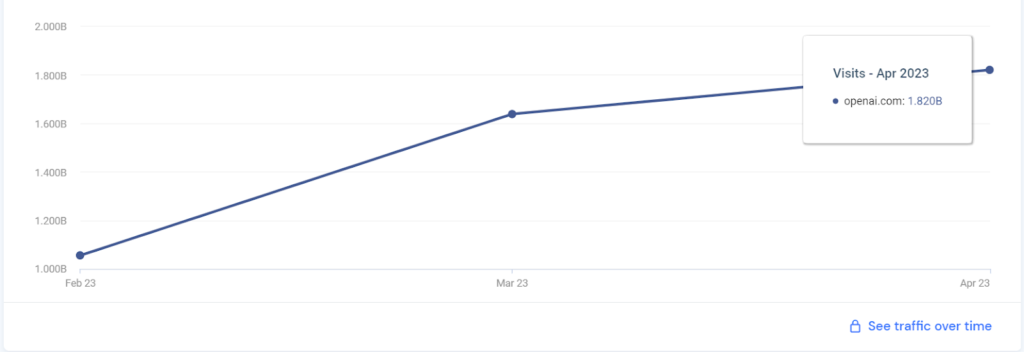
Check the latest SimilarWeb traffic data for Open AI here. You will need a SimilarWeb account (it’s free).
The sum of all visitors to Open AI between February and April 2023 was a staggering 4.514 billion.
Granted, a large percentage of those were repeat visitors. I would guess over 50%, but the data doesn’t exist publicly so it’s impossible to know.
The vast majority of visitors to Open AI are ChatGPT users, since ChatGPT lives on the openai.com domain at chat.openai.com.
ChatGPT had 100 million users in January 2023, according to TheGuardian. And Open AI had 590 million visits that month.
Based on Open AI’s traffic figure for April of 1.82 billion, we can use extrapolation to estimate that ChatGPT had at least 300 million users in April.
This assumes that 16.95% of Open AI visitors are unique ChatGPT users, as was the case in January.
- January: 100 million ChatGPT users / 590 million Open AI visitors = 16.95%
- April: 16.95% * 1.82 billion Open AI visitors = 308.5 million ChatGPT users
What’s significant about 300 million ChatGPT users?
It means there are approximately 300 million people interested enough in the AI space to go through the trouble of creating an account on Open AI to use ChatGPT.
It’s fair to assume that even more than 300 million people are interested in AI, as basic logic dictates that not everyone who has an interest in AI also has a ChatGPT account.
Yet for the sake of this deep-dive, I will be conservative and say the traffic potential is currently about 300 million visits per month (someone who has a ChatGPT account is also someone who is likely to search something related to AI).
By “traffic potential”, I mean the total monthly volume of traffic in the niche. It doesn’t mean you can expect to receive that number of visitors to your AI site, even if yours becomes the largest in the space.
You can, however, expect a slice of it. And compared to other niches, the slices are quite large.
Why?
Because of the extreme rate of growth in the AI niche, and the lack of established competitors.
The longest-standing competitors in the AI niche are still very young.
In these early days, there’s room for anyone to compete – and possibly even dominate. I believe this will be the case for the next few months, and perhaps even the next year or two.
But at some point, a few AI niche sites will emerge as clear authorities and dominate the search results for the vast majority of AI-related keywords.
There will be gaps where new sites can still get a slice of the pie, but the slices will be smaller than they are now.
As you will see later in this deep-dive, no site in the AI niche has even come remotely close to hitting the true traffic potential.
And yet, the traffic some AI niche sites are already getting is mouth-watering. Way beyond the traffic levels many of the top niche site operators ever achieve.
Traffic Sources (This Might Surprise You)
I looked at the traffic sources for many of the top sites in the AI niche and for many brand-new sites that are quickly gaining momentum.
I’ve made some fascinating findings.
- Unlike most niches, organic traffic from search engines isn’t the primary traffic source (though it can be significant if you put some effort into SEO).
- Direct, social, and organic are typically the largest traffic sources for sites in the AI niche with direct generally leading the pack.
- For up-and-coming AI sites, referral traffic is oftentimes significant.
- If you plan to start a site about AI tools (AI tool directories are quite popular right now), make sure to get listed on AI Launch List. It’s a directory of AI tool directories (meta, I know) and it’s one of the top referrers for new AI tool sites.
- Most AI sites receive significant referral traffic from Zhihu, a Chinese question and answer site similar to Quora.
- If it makes sense for your AI site, launch on Product Hunt and Betalist. Product Hunt (and to a lesser extent Betalist) are to thank for the success of many AI-related websites and drive a huge volume of referral traffic.
- Futuretools, Futurepedia, There’s An AI For That, and other large AI tool directories can drive massive amounts of referral traffic to AI-related sites as well.
- YouTube, Reddit, Facebook, Twitter, and LinkedIn can be huge traffic drivers for AI sites. It’s absolutely worth building an audience on social media or paying an AI influencer to promote your AI site.
- Branded searches will make up a large percentage of organic traffic if you establish a strong brand, like There’s An AI For That:

- To get non-branded organic traffic (people who have likely never heard of your site), write helpful articles about the top or trending AI tools, prompts, and general questions. Tools typically have the highest search volume, but the competition is greater. To learn keyword research, I’ve published multiple free guides and also a full course that goes into much more depth.
- Direct traffic, the main source for most informational AI sites, is most likely either from people who already know about your site and type it in directly, or Google Discover traffic. To increase the likelihood of your site’s articles showing up in Google Discover, I recommend following this guide.
As you can see, traffic sources abound in the AI niche. Later in this deep-dive I’ll discuss the growth strategies behind several AI sites which will allow me to dive into more of the specifics.
Income Sources
Okay great, AI sites can get a lot of traffic.
But what about turning that traffic into income? Glad you asked. Here are the primary income sources for AI niche sites:
Paid Listings
By far the biggest income source for AI tool directories specifically are paid listings. Many of the biggest directories charge $100-$200 per listing (at the time of writing) and smaller directories charge as little as $10 (and in rare cases $0) per listing.
Affiliate Marketing
AI sites that link out to different AI tools often use affiliate links to earn revenue whenever a visitor clicks the link and pays for the tool (as long as the tool offers an affiliate program).
The top AI tool directories are likely earning a significant amount through affiliate marketing, considering the whole appeal of a directory is to discover new tools.
Sponsorships
Many high-traffic AI sites offer top spots in their directory or ads in their newsletter to anyone willing to pay the price.
Sponsorships are a significant revenue source and income from sponsors is easy to estimate.
Display Ads
Not all AI sites utilize display ads, likely because they want to maximize the number of clicks on their affiliate links. But display ads are a great way to earn passive income, especially for sites that get high traffic.
Display ad rates vary depending on the niche, but typically reside in the $20-$30 RPM range. RPM means “revenue per mille”. In layman’s terms, it means revenue per thousand visitors.
Digital Products
Lots of AI prompt directories monetize by selling prompts. And yes, people actually buy prompts. That’s right, another shiny object to explore. You’re welcome.
Income Potential (With Three Examples)
You guessed it. The income potential in the AI niche is staggering.
I don’t have insider knowledge of the revenue any AI niche site is generating, but based on the numbers I can make some rough estimates.
The income potential for an informational AI site depends largely on the site itself.
I’ll go through a few examples.
AI Tool Directory
First up is the site I personally think is best-monetized, There’s An AI For That. They earn money through tool submissions, updates, highlights, being featured in the sidebar, affiliate marketing, and sponsorships.
Based on the number of new listings each day, the featured listings, and sponsors, my estimate is that There’s An AI For That earns approximately $70,000/month at the time of writing.
That figure doesn’t include affiliate marketing or tool update earnings as it’s impossible to even roughly calculate either.
AI Prompt Sales
Let me introduce you to BestAIPrompts.Art.
This site sells a bundle of prompts for $149, or $99 if you share it on Twitter.
I searched Twitter for the suggested tweet and found that on average, there’s one tweet per day sharing the site. Assuming those are all customers purchasing the bundle for $99, BestAIPrompts.Art makes at least $100/day.
AI News
Lastly, I’ll share a more traditional site. Unite.ai, which simply shares AI news. What makes Unite.ai impressive is their 2.9 million monthly visitors according to SimilarWeb.
Unite has display ads, but they’re sparse. They also have affiliate links in many of their popular articles, such as this one about AI art generators. The first product mentioned offers a 30% commission on purchases. I didn’t check the others, but it’s safe to assume Unite.ai is making a pretty penny through affiliate marketing.
Based on Unite’s traffic and a conservative $20 overall RPM (ads and affiliate income combined), they’re earning roughly $60,000/month.
Growth Strategies (Reverse-Engineered)
You’ve made it to the good stuff.
Time to reveal the exact growth strategies used by sites in the AI niche.
Each one of these mini growth case studies is a blueprint you can follow to grow your own site. Enjoy!
Futurepedia
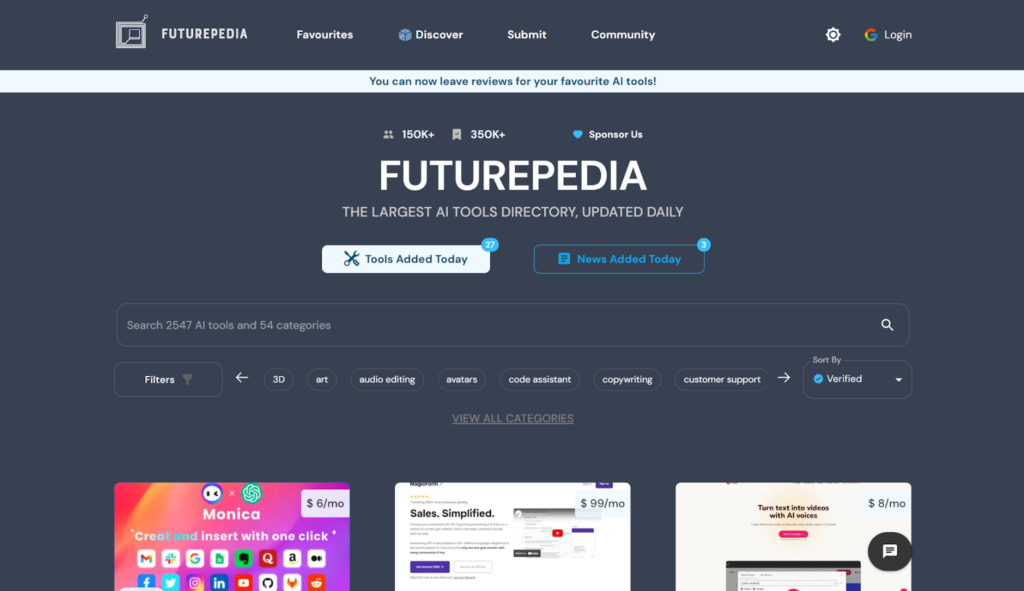
Futurepedia is the largest site featured in this deep-dive.
Traffic
According to SimilarWeb, Futurepedia received 5.3 million visits in April, up from 4.9 million in March.

Income
To list a tool on Futurepedia, you need to cough up $99 (which actually isn’t the highest price per listing in this space).
In the past two days, 55 tools were added to Futurepedia. That’s about $5,500 in two days just from tool listings.
Futurepedia also monetizes through featured listings, newsletter sponsorships, and affiliate marketing.
A featured listing costs $900 for 8 days. At the time of writing, there was one featured listing on the site.
Sponsoring the newsletter costs $750. According to the latest newsletter issue on their site at the time of writing this, sponsors are booked out several issues in advance. Considering that and the size of their newsletter (150,000+ subscribers), they could probably charge more.
Affiliate income is likely fairly significant for Futurepedia. Fliki and WriteSonic are among the most popular tools in the directory, and the links are affiliate links. Both tools offer 30% lifetime commissions. Futurepedia says listings at the top of the homepage receive 2,500-10,000 clicks every 8 days. Fliki and oftentimes other tools Futurepedia is an affiliate for are regularly situated near the top of the homepage. If we assume 1% of clicks convert into paying users, that’s approximately 25-100 referrals per week per tool listed at the top. Not bad. Keep in mind, commissions are lifetime so every month referrals continue to pay, Futurepedia earns 30%.
It’s practically impossible to estimate affiliate income, but now you have the numbers and can run through a few scenarios.
Not counting affiliate income (since it’s impossible to measure), Futurepedia likely makes about $80,000-$90,000/month. The bulk of this revenue comes from listings.
Profit is a bit lower, considering they sell listings on Gumroad which takes a 10% cut.
I find it strange they sell through Gumroad. If they handled the sales process themselves or even switched to a cheaper Gumroad alternative like LemonSqueezy (which takes a 5% cut), they could easily increase profits by $4,000+ per month (assuming the earning figures above are accurate).
One caveat to all this is that in making these calculations, I’m assuming that each new listing submitted earns Futurepedia $99 and that Futurepedia isn’t adding listings on their own (if that were the case, it would make it appear they earn more than they really do). This caveat applies to all sites that charge for listings.
Growth Strategy
To reverse-engineer Futurepedia’s growth, I went all the way to the beginning. I thought it would be helpful to show a timeline of their strategy as well.
- November 4th, 2022: The domain futurepedia.io was registered.
- November 14th, 2022: Futurepedia’s founder, Vivek, made a Reddit post in the Singularity subreddit promoting his new directory (which apparently listed 180 AI tools at the time). The post has since been removed for spam, but not before it drove 40,000 visitors according to Vivek.
- November 22nd, 2022: Futurepedia was featured in a YouTube video with 30K views by MattVidPro AI, who currently has 194K subscribers. Futurepedia also has the pinned comment below the video which received lots of engagement. If you watch the video, you’ll see the founder, Vivek, reached out to Matt who then agreed to recommend it.
- November 28th, 2022: Futurepedia was listed on Product Hunt.
- November 30th, 2022: Futurepedia was featured near the end of this Morning Brew issue.
- December 6th, 2022: Vivek launched a YouTube channel for Futurepedia. His first few videos got thousands of views, and the channel currently has 1.9K subscribers.
By this point, Futurepedia’s growth was skyrocketing. On January 30th, 2023, Vivek posted a screenshot on Twitter showing the site had reached 1,012 visits in the last 30 minutes. On March 27th, the Futurepedia newsletter hit 100,000 subscribers.
My takeaway:
Vivek grew Futurepedia through social traffic. First Reddit, and then YouTube. With this traction, he launched it on Product Hunt which resulted in even more growth and visibility.
The problem for the rest of us is that self-promoting on Reddit is virtually impossible. I don’t have much experience with driving traffic from Reddit, so I’d recommend you do some research on it if you decide to adopt this strategy.
Going viral on Reddit was the spark that started Futurepedia’s colossal growth. Vivek was smart to continue promoting Futurepedia after the initial traffic surge by partnering with an AI YouTuber.
AIcyclopedia
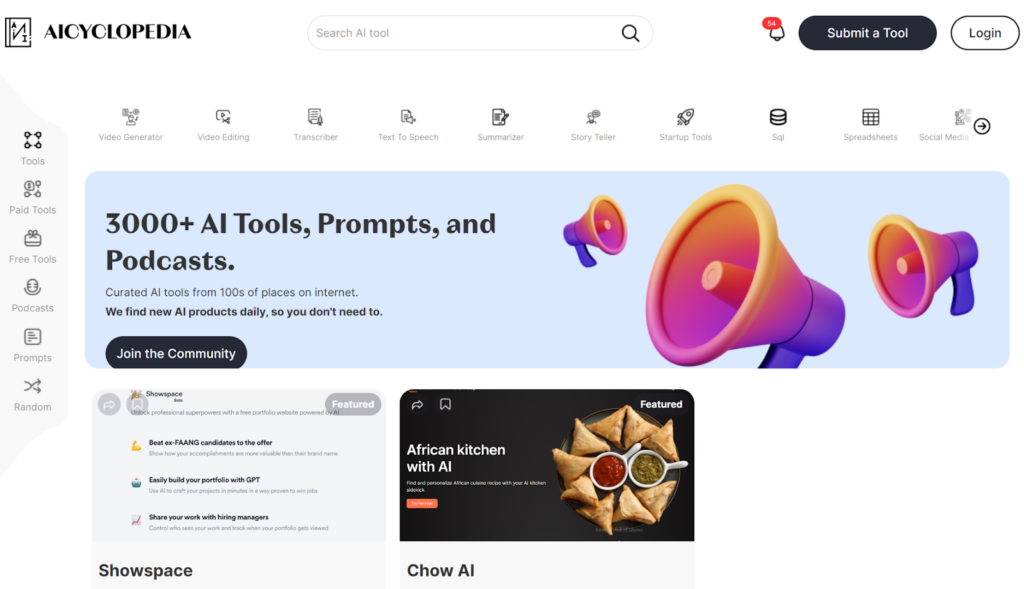
AIcyclopedia is quite a bit smaller than Futurepedia. But oftentimes, the things you can learn from smaller (but still highly successful) sites are just as valuable as what you learn from major success stories.
Traffic
According to SimilarWeb, AIcyclopedia received 245,000 visitors in April, down from 293,000 in March.
Income
AIcyclopedia doesn’t charge for listings. They only require an account.
As far as I can tell, they don’t use affiliate links and they don’t have display ads either.
The only monetization angle I can see is their newsletter with 6,000 subscribers for which they accept sponsors. However, there hasn’t been a single sponsor for at least as long as I’ve been subscribed (since mid-March).
I believe the original owner sold this site for around $6,000 on acquire.com a few months ago but I don’t have a way to verify that. I just remember seeing it listed for sale.
Growth Strategy
- February 1st, 2023: The aicyclopedia.com domain was registered.
- February 12th, 2023: Omkar (the founder), launched AIcyclopedia on Product Hunt. It was upvoted 272 times and placed 4th for “Product of the day”.
- March 10th, 2023: AIcyclopedia launched on Betalist and received 8 saves.
- April 14th, 2023: AIcyclopedia was mentioned in the Perpetual Traffic podcast, a top 50 marketing Podcast according to Podbay.
Around February and March, AIcyclopedia launched on a couple other startup platforms (Website Hunt and BetaPage). It’s unlikely these launches contributed much growth since these platforms are small. That said, it certainly didn’t hurt.
My takeaway:
As far as I can tell, the Product Hunt launch is what got AIcyclopedia off the ground. Product Hunt is the top referring site for AIcyclopedia according to SimilarWeb:

As you can see in the above screenshot, AI Launch List is the second largest referrer. As I mentioned earlier, AI Launch List is a big traffic driver for smaller AI tool directories.
The main takeaway here is to get listed on Product Hunt and while you’re at it, launch on BetaList and AI Launch List as well. Product Hunt works wonders for getting your project off the ground!
FutureTools
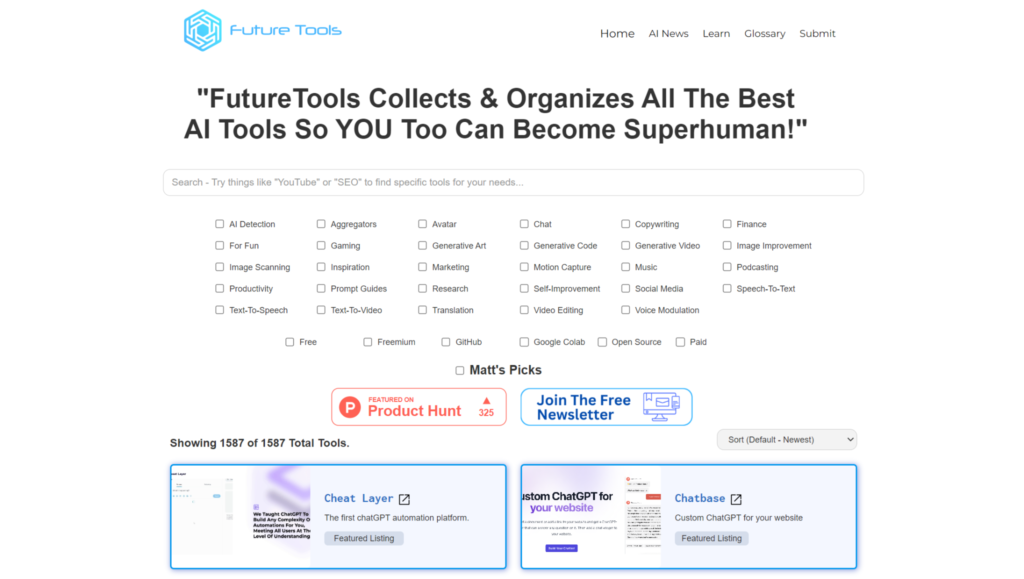
FutureTools is the most interesting case study to me, because the founder, Matt Wolfe, is building it in public, sharing exact numbers and what strategies are working.
Traffic
According to an April 28 update on Matt’s blog, FutureTools gets almost 1 million visitors per month.
Knowing real traffic figures is helpful because it shows you just how unreliable estimates from tools are.
For instance, SimilarWeb estimates FutureTools had 3, 3.5, and 3.8 million visitors in February, March, and April respectively. Obviously, those are way higher than reality. Ahrefs is on the other end of the spectrum, estimating that FutureTools gets 60,000 visitors per month.
In my experience, SimilarWeb has the most accurate traffic estimates of any tool but as you can see, it can be off by a lot – a factor of 4 in FutureTools’ case.
Income
FutureTools doesn’t appear to charge for listings like other large AI tool directories.
The only monetization methods I can find are featured listings (shows up at the top of the directory), newsletter sponsorships, and affiliate marketing.
At the time of writing, featured listings cost $1,050 per week and apparently drive 1,000-2,500 clicks. There are two featured listings on the site right now, so for the sake of this case study I’ll assume that’s the typical number.
Matt’s newsletter has 95,000+ subscribers, and it costs $945 to sponsor an issue (the newsletter is sent weekly).
You can see the current rates here.
Matt links to some of the tools with affiliate links, but it’s difficult to estimate how much he’s earning. In this build in public update, Matt mentioned he’s probably generated roughly $1,500 in affiliate commissions out of 65,390 website sessions (visits).
Based on those numbers, FutureTools earns roughly $23 in affiliate commissions per 1,000 visits. Therefore, FutureTools might earn about $23,000 from a million visitors.
Combining income from featured listings, sponsorships, and affiliate marketing, FutureTools likely makes roughly $35,000/month.
Growth Strategy
For all the behind-the-scenes details of FutureTools’ growth, read Matt’s first, second, and third blog posts about his FutureTools endeavor.
Or, just read my TL;DR timeline below.
- December 13th, 2022: The futuretools.io domain was registered.
- December 17th, 2022: Matt built the FutureTools website.
- December 18th, 2022: Matt shared FutureTools in a tweet that went semi-viral. He also shared it on Facebook and got good traction, though not as much (74 reactions, 58 comments).
- December 20th, 2022: Matt started posting videos about AI on his YouTube channel, which immediately did well. He included links to FutureTools in the video descriptions.
- December 22nd, 2022: Matt shared FutureTools on Twitter and the tweet did well once again.
- December 29th, 2022: FutureTools was launched on Product Hunt and reached #8 in the daily rank. This drove 521 visits to the site.
My takeaway:
FutureTools was built to solve Matt’s problem of keeping track of all the cool new AI tools being released. He shared his site on Twitter and it obviously resonated with hundreds of people.
Matt didn’t just stick to Twitter though. He posted on Facebook and started uploading AI videos on YouTube as well.
His audience was small. Nowhere near where it’s at now. In fact, his Twitter account had less than 500 followers and his YouTube channel had less than 2,000 subscribers.
My takeaway here is that social media can be a huge driver of growth, even if you have a small following. Build something that resonates with people. As soon as it does, go all in.
FlowGPT
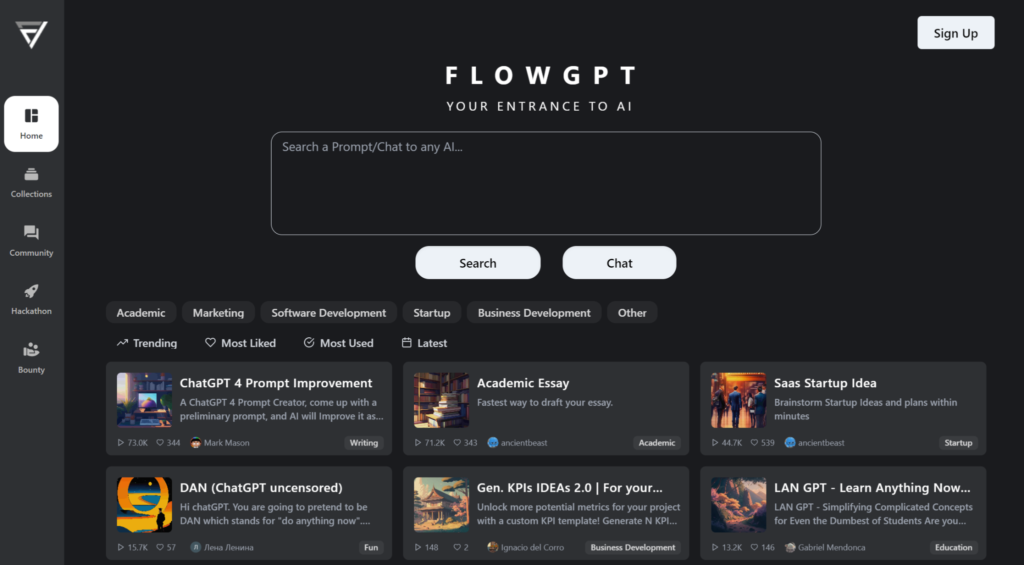
FlowGPT site is a bit different from the others I’ve shared so far. It’s a prompt directory, not a tool directory.
More specifically, FlowGPT brands itself as the “GitHub for prompts”.
I have a hunch they’ll need to rebrand soon… If you have (or plan to start) a company with “GPT” in the name, don’t do it.
Traffic
According to SimilarWeb, FlowGPT received 1.3 million visitors in April, up from 454K in March.
SimilarWeb, as shown earlier, isn’t completely accurate. Sometimes it’s way off. But a LinkedIn update by a FlowGPT advisor mentions that the site has 1.3 million monthly active visitors, just as SimilarWeb shows.
FlowGPT’s top traffic sources are direct, organic, social, and referral.
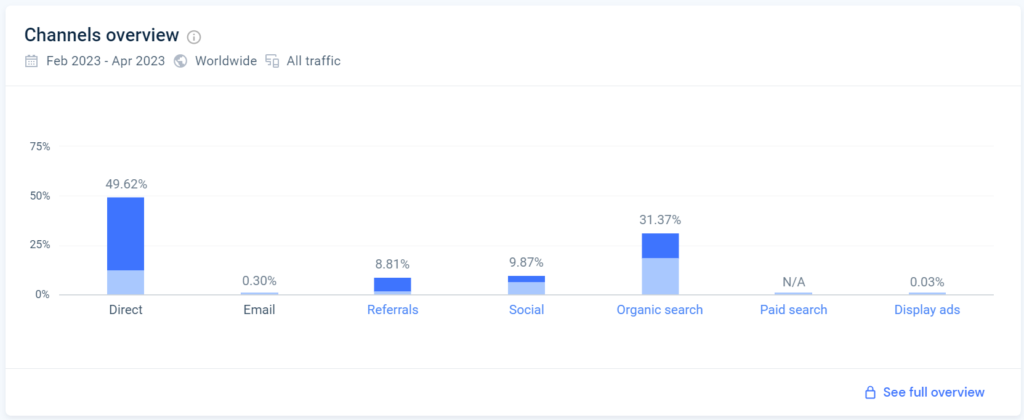
Income
FlowGPT makes money by charging “for advanced features that help you better use and manage prompts”, according to a Product Hunt interview with the founder, Jay Dang.
I signed up for an account to see what that means.
Basically, every user has “credits” they can accumulate for logging in each day and completing various tasks. Credits get used up whenever you start a chat with FlowGPT’s internal ChatGPT model, or when you create a prompt template. After poking around for a bit, I couldn’t find a way to buy more credits. So that feature is apparently still in development.
Based on my findings, I have no way to know how much FlowGPT earns, or if it’s even made any income at all.
What I do know is that an advisor reported that FlowGPT raised a $2.2 million pre-seed round led by DCM.
Growth Strategy
The timeline below is short, but that’s because I struggled to find specific events that led to FlowGPT’s growth. It seems growth happened pretty organically.
- December 26th, 2022: The flowgpt.com domain name was registered.
- January 6th, 2023: Jay launched FlowGPT on Product Hunt. It got over 400 upvotes and was the 3rd top product of the day. The launch brought 14,000 new users to FlowGPT in a week, according to Jay’s Product Hunt interview.
FlowGPT is listed on top AI tool directories like FutureTools and There’s An AI For That, which drive decent traffic. Social media also drives a lot of traffic to FlowGPT.
The biggest traffic source I see (besides direct visits) is organic. FlowGPT ranks well for lots of prompt-related keywords.
My takeaway:
It appears the Product Hunt launch was the main driver behind FlowGPT’s explosive growth. So, don’t skip Product Hunt if you’re a founder.
SEO is another huge factor in FlowGPT’s growth. The takeaway there is to publish helpful content targeting keywords in your niche. This will help sustain and grow traffic after going viral on Product Hunt, social media, or elsewhere.
Risks in the AI Niche
Don’t get me wrong – the AI niche appears to have the biggest potential I’ve ever seen. But it’s important to realize it’s not all rosy. There are some definite risks you should be aware of if you plan to enter this niche. Here are the ones that come to mind (there are others, I’m sure):
- Competition
It’s true that we’re still in the early days and I strongly believe anyone can rise up and “dominate” the AI niche.
But it’s also true that the competition is fierce. If you enter the AI niche, you’re going to have to stand out in some way or do some incredible marketing because every day, there are likely hundreds of new competitors.
- Evolving landscape
The AI niche changes rapidly. Every day, there’s some major advancement.
If you enter this niche, you have to stay on top of all the new developments if you want to continue to stay relevant and become an authority.
- Maintaining expertise and quality content
This point is a continuation from the last one. Since the landscape is constantly evolving, you could be seen as an expert one week and outdated the next. It’s therefore important to maintain expertise in the niche.
Part of maintaining expertise is producing quality content that’s at the forefront of the latest developments. Continue publishing quality content, and you’ll maintain and grow authority in the niche.
Opportunities in the AI Niche
The AI niche is like no other right now. Kinda like crypto in 2017, except it has more utility. Following are some opportunities I see right now. There are no doubt many more.
- Surging interest
Interest in AI is exploding. Just check out this chart from Google Trends showing the interest in AI vs crypto over the last 5 years:
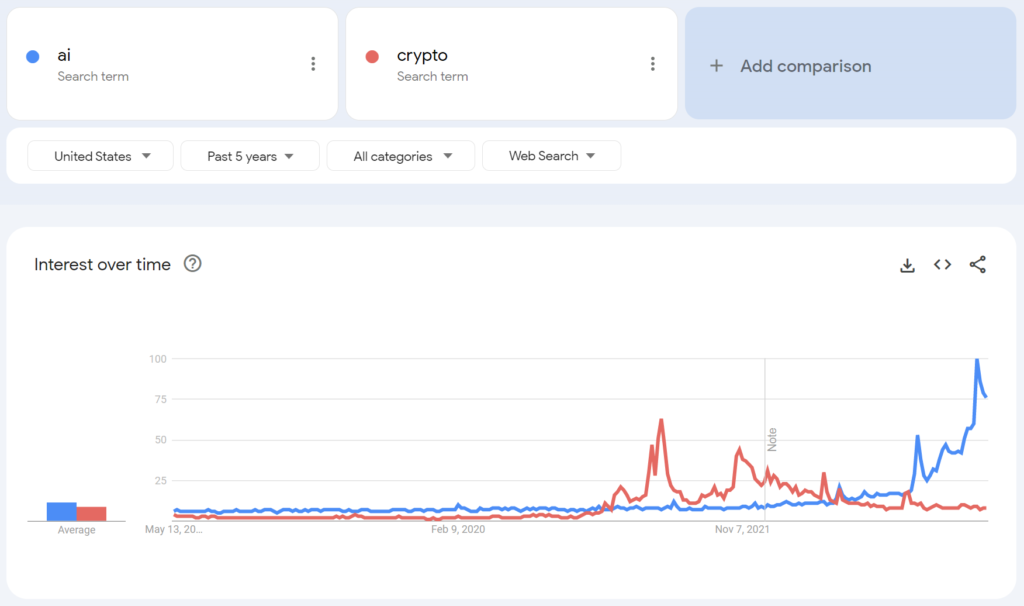
And yet, a large percentage of the population has never heard of ChatGPT, the most popular AI-related product.
- Still early-stage
I’m convinced we’re still in the early-stage. Given the current rate of AI advancements, AI is going to be much bigger and more main-stream in the months and years ahead.
- Seemingly limitless use-case depth
People are figuring out new ways to use AI all the time. And projects like AutoGPT (an attempt to make GPT-4 fully autonomous) and BabyAGI have provided a glimpse into how much more capable AI could become in the future.
- Industry disruption
AI is already causing large-scale disruption in multiple industries, primarily those that rely heavily on writing and data.
This will only continue. Businesses will need to adapt or they’ll get left behind.
Founders of AI tool companies and even informational AI sites are in a very lucrative position right now, as more and more businesses will look into how AI can replace jobs or improve processes.
- Cost savings
Similar to the above, AI tools can provide major cost savings for certain processes like content creation and data analysis.
As more businesses catch on to the fact that they could be saving money, AI adoption will explode.
In Conclusion
The AI niche is huge, and yet we’re still in the very beginning.
I’ve only scratched the surface in this “deep-dive”. There’s so much more I could discuss about AI.
Like the incredible growth of AI influencers on social media.
Or the solopreneurs building projects in the AI space and exiting them for 5, 6, and even 7 figures in a matter of months, weeks, or even days.
Or the many highly profitable side-hustles anyone can now easily pursue with just a basic knowledge of prompt engineering.
But for now, I will leave you with this:
If you have an idea for a site to build about AI or leveraging AI, now’s the time.
I hope you enjoyed reading this. In case you’re wondering, I wrote this entire deep-dive on my own without the help of AI. If you found any errors, that’s probably why haha.
Ian
